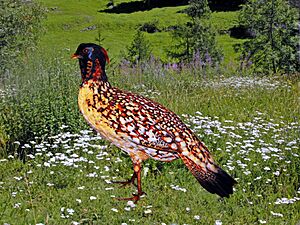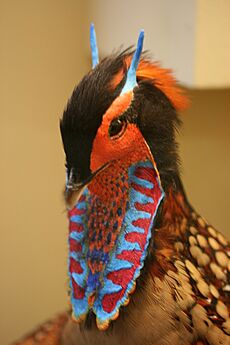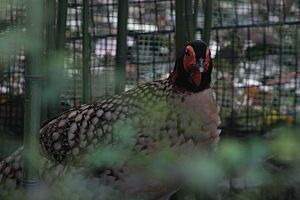Cabot's tragopan facts for kids
Quick facts for kids Cabot's tragopan |
|
|---|---|
 |
|
| Conservation status | |
| Scientific classification | |
| Genus: |
Tragopan
|
| Species: |
caboti
|
The Cabot's tragopan (Tragopan caboti) is a beautiful and rare pheasant that lives in the mountains of southeastern China. Both its common name and scientific name honor an ornithologist named Samuel Cabot III. This bird is also sometimes called the Chinese tragopan or the yellow-bellied tragopan. It is considered a "vulnerable species" by the IUCN, which means it needs our help to survive.
Contents
What Does It Look Like?
The Cabot's tragopan is a plump bird that spends most of its time on the ground. It has fairly short legs. Male tragopans are quite colorful and grow to about 60 cm (24 inches) long. They weigh around 1.4 kg (3 pounds).
The male's head is black with bright reddish-orange stripes on the sides and neck. It also has bare, reddish-orange skin on its cheeks and around its eyes. Below its beak, there are blue and orange flaps of skin called wattles. These wattles can inflate, making them look like a fancy beard! Above its eyes, it has two fleshy blue "horns." The top part of the male's body is reddish-brown with large, light brown spots. Its belly is a straw-yellow color.
Female tragopans are not as colorful as the males. Their heads and upper bodies are reddish-brown with black spots and white, triangle-shaped patches. Their undersides are greyish-brown with white markings. Females are a bit smaller than males, growing to about 50 cm (20 inches) long and weighing around 0.9 kg (2 pounds).
Where Do They Live?
Cabot's tragopans are only found in the mountain ranges of southeastern China. They live in provinces like Fujian, Guangdong, Guangxi, Hunan, Jiangxi, and Zhejiang. Their favorite homes are subtropical evergreen forests. They also live in other forests that have a mix of trees, both deciduous (trees that lose their leaves) and coniferous (trees with needles, like pine trees).
These birds can be found at high altitudes, from about 600 to 1800 meters (2,000 to 6,000 feet) above sea level. They can even live above the treeline, where trees stop growing. Sadly, their groups are spread out because they don't move easily across large open areas. They usually won't cross gaps in the forest that are wider than 500 meters (1,600 feet).
How Do They Behave?
Cabot's tragopans usually look for food on the ground. They eat roots, young shoots, buds, flowers, fruits, and seeds. One of their favorite foods is the fruit and leaves of a small tree called Daphniphyllum macropodum. They also like to roost (rest) in these trees at night. Sometimes, they will eat small invertebrates like insects.
Breeding season for these birds is in the spring. Male tragopans have a special dance and display to attract females. Nests are usually built off the ground in the fork of a tree. They are made from grasses, moss, feathers, and leaves. Sometimes, they even use an empty nest that another bird has left behind.
A female tragopan will lay two to six eggs. She is the only one who sits on the eggs to keep them warm. The eggs hatch in about 28 days. After the chicks hatch, the mother broods (sits on) them for two or three more days. Then, the whole family leaves the nest together. The chicks can fly very soon after they hatch! They stay with their family through the winter, and sometimes even join another family group.
Why Are They Vulnerable?
The International Union for Conservation of Nature (IUCN) has listed the Cabot's tragopan as a "vulnerable species." This means their population is decreasing, and there are fewer than 10,000 of these birds left in the wild.
The biggest danger to Cabot's tragopans is the loss of their home, or habitat. Forests where they live are being cut down to make space for farms or plantations of trees like conifers and bamboo. This also means there are fewer good places for them to build their nests in tree forks. People are trying to help by providing artificial nesting platforms.
Even though some areas are protected, these protected zones are often small. Illegal hunting is also a problem in some places. Zoos, like Zoo Praha, are working to breed these birds to help increase their numbers and protect them for the future.
See also





